| Type | Two seat sportplane | |
| Engine | 1 Argus As 8 R 150 hp, two-bladed wooden prop. dia 1.90 m. |
|
| Dimensions | Length 6,6 m, height 2,4 m, span 7,4 m, wing area 13,0 m2 | |
| Weights | Empty 345 kg, fuel 140 l, oil 14 l , flying weight 600 kg, payload 255 kg | |
| Performance | Max. speed 230 km/h, cruising speed 200 km/h, stall speed < 81,8 km/h, range 800 km, service ceiling 6200 m | |
| Type | Werk.Nr | Registration | History |
| G-ABPX | Sold to England but crashed in Jan 1932, had a DHGipsy III engine | ||
| a | D-2222, D-EQIN | Delivered to the Reichsverkehrsministerium. Took part in the Europa-Flug 1932, second place. Crashed in March1935, the pilot Ing. Biedermann was killed |
The plane was designed by F. Fecher in the Akaflieg (academic group of flyers) of Darmstadt University of Technology. It was a development of Darmstadt D-18, slightly enlarged, more streamlined and fitted with an inline engine. Thanks to strengthening it was better fit to aerobatics. Two were built in 1931.
Just like D-18, the plane had quite unorthodox layout, being a cantilever biplane, with an upper wing placed low above a fuselage and ahead of a lower wing. A stress was put upon aerodynamics and lightness and the plane was small, with a streamlined silhouette
One plane, in D-22a variant, took part in the Challenge 1932 international tourist plane contest, piloted by Walter Marienfeld. It was handicapped in technical trials, especially short landing trial, not having wing mechanization, and took the 35th place after this part (for 43 aircraft). It improved its score after a rally around Europe, where it took the 4th place, with a cruise speed 205 km/h. In a maximum speed trial it was beaten only by five Heinkel He 64s, reaching 230.7 km/h. As a result, it completed the contest on the 17th place. This plane carried registration D-2222, from 1933: D-EQIN. It was used several year after the Challenge.
Wooden construction cantilever biplane. Fuselage oval in cross-section, plywood covered. Single-spar wings, plywood and canvas covered. Wings were dismounting and folding rearwards. Two open crew cockpits in tandem, with windshields. Fixed landing gear with a rear skid. Inline engine in a fuselage nose, two-blade propeller. Fuel tank 100 l in the fuselage.
Just like D-18, the plane had quite unorthodox layout, being a cantilever biplane, with an upper wing placed low above a fuselage and ahead of a lower wing. A stress was put upon aerodynamics and lightness and the plane was small, with a streamlined silhouette
One plane, in D-22a variant, took part in the Challenge 1932 international tourist plane contest, piloted by Walter Marienfeld. It was handicapped in technical trials, especially short landing trial, not having wing mechanization, and took the 35th place after this part (for 43 aircraft). It improved its score after a rally around Europe, where it took the 4th place, with a cruise speed 205 km/h. In a maximum speed trial it was beaten only by five Heinkel He 64s, reaching 230.7 km/h. As a result, it completed the contest on the 17th place. This plane carried registration D-2222, from 1933: D-EQIN. It was used several year after the Challenge.
Wooden construction cantilever biplane. Fuselage oval in cross-section, plywood covered. Single-spar wings, plywood and canvas covered. Wings were dismounting and folding rearwards. Two open crew cockpits in tandem, with windshields. Fixed landing gear with a rear skid. Inline engine in a fuselage nose, two-blade propeller. Fuel tank 100 l in the fuselage.
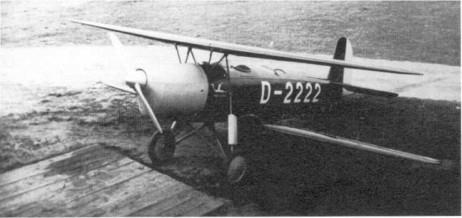
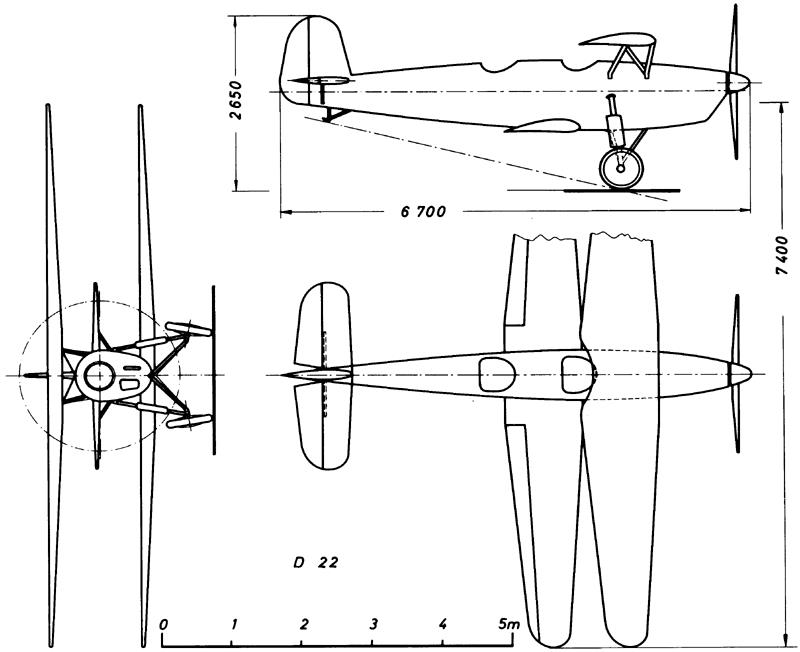

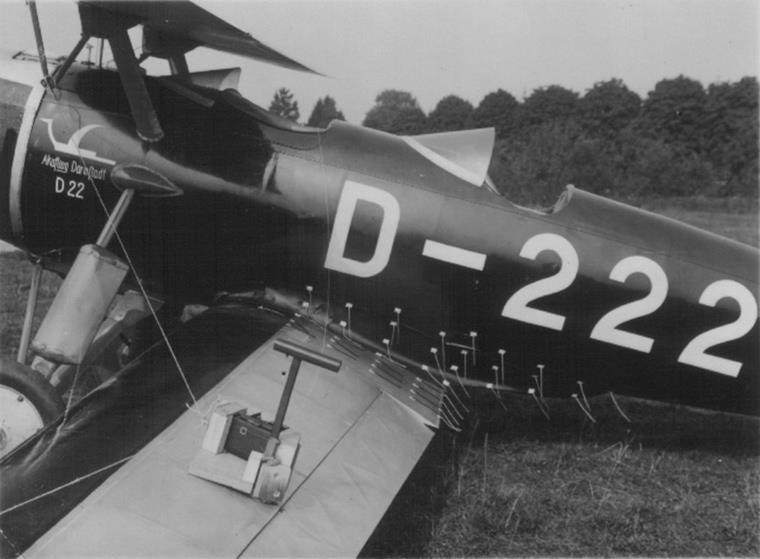
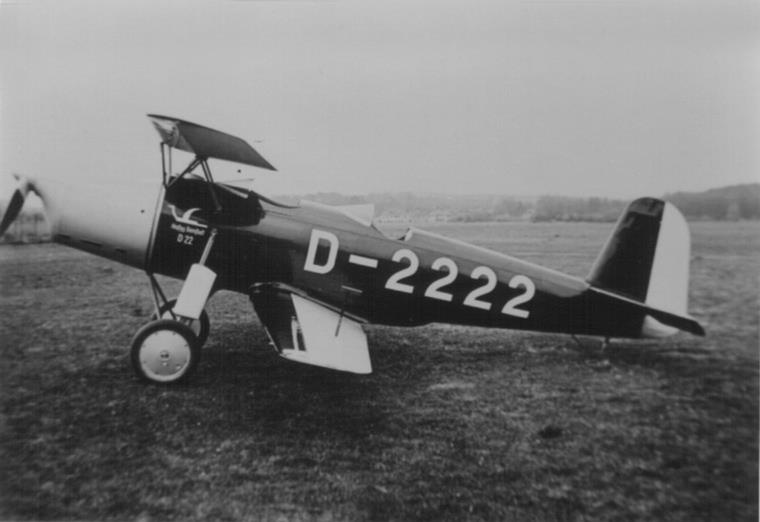


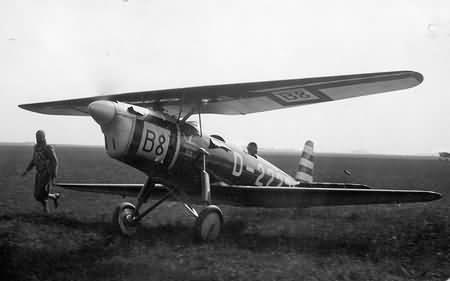

D22 biplane of the Academic Flying Group Darmstadt
The D 22 of the Academic Flying Group Darmstadt was designed and built at the time without any particular consideration for a European flight. The only decisive aspect was to build a sports aircraft with high performance in terms of both speed and climbing ability. The intention was to build the aircraft for both cruising and aerobatics. This meant that the aircraft had to be built as an open machine.
The ability to be dismantled quickly was largely taken into account, i.e. the aircraft was designed and constructed in such a way that it could be assembled and disassembled within 4 minutes, which was also done on the European tour.
The chassis and the tail fin were designed for very heavy use, as is sometimes said to occur in "competitions". The suspension of the chassis and tail fin consists of pressure rubber discs with electronic plates mounted between them.
The seats were designed so that no bumpers, cables or lines are visible. The entire control system disappears under a double floor and the lines are routed in side channels. In the driver's compartment (see also below aircraft cabins) only instruments, the control levers and protruding buttons are visible. The horizontal stabilizer on this machine can be adjusted in flight using a handwheel. The strength of the machine is chosen so that it can be used as a single-seater according to group S 4 and with a larger payload for group P 3.
The machine is made entirely of wood. The wings are single-spar with a torsionally rigid plywood nose, as are the fins. The ailerons on the first machine were made of metal, but for weight reasons they were made entirely of wood on the second version.
The D 22 of the Academic Flying Group Darmstadt was designed and built at the time without any particular consideration for a European flight. The only decisive aspect was to build a sports aircraft with high performance in terms of both speed and climbing ability. The intention was to build the aircraft for both cruising and aerobatics. This meant that the aircraft had to be built as an open machine.
The ability to be dismantled quickly was largely taken into account, i.e. the aircraft was designed and constructed in such a way that it could be assembled and disassembled within 4 minutes, which was also done on the European tour.
The chassis and the tail fin were designed for very heavy use, as is sometimes said to occur in "competitions". The suspension of the chassis and tail fin consists of pressure rubber discs with electronic plates mounted between them.
The seats were designed so that no bumpers, cables or lines are visible. The entire control system disappears under a double floor and the lines are routed in side channels. In the driver's compartment (see also below aircraft cabins) only instruments, the control levers and protruding buttons are visible. The horizontal stabilizer on this machine can be adjusted in flight using a handwheel. The strength of the machine is chosen so that it can be used as a single-seater according to group S 4 and with a larger payload for group P 3.
The machine is made entirely of wood. The wings are single-spar with a torsionally rigid plywood nose, as are the fins. The ailerons on the first machine were made of metal, but for weight reasons they were made entirely of wood on the second version.







